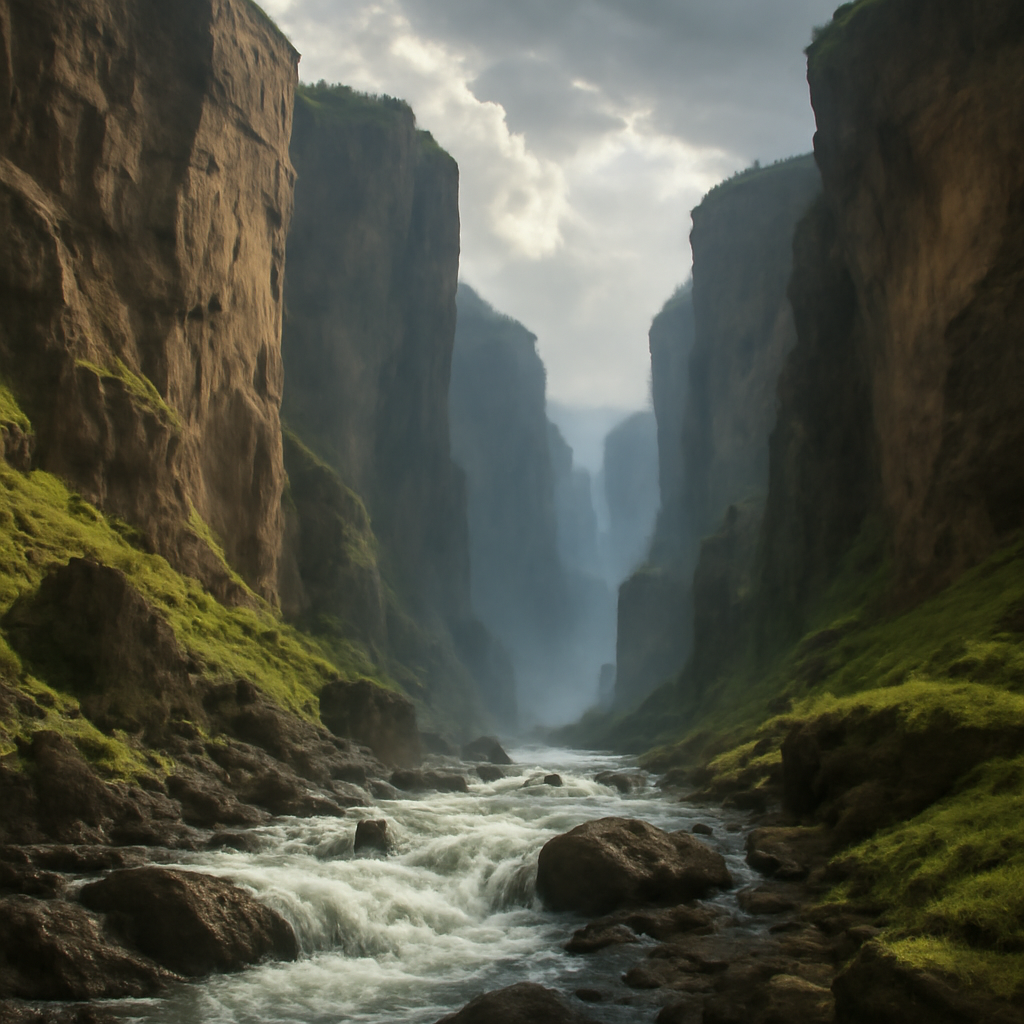Key Takeaways
- Eat refers to the demarcation lines drawn between nations or regions, often representing political, cultural, or geographical boundaries.
- Gorge, in the context of boundaries, indicates a deep, often valley-like separation between territories that may act as natural borders or strategic passes.
- While Eat boundaries are frequently formalized through treaties or agreements, Gorges tend to be physical features that influence boundary positioning.
- Understanding the distinction helps clarify geopolitical disputes, where some borders are contested over political reasons, and others over physical terrain features.
- Both concepts are crucial in shaping regional identities, security considerations, and cross-border interactions, but their origins and implications differ significantly.
What is Eat?

In the geopolitical context, an Eat is a boundary line separating various territories, often established through political processes, treaties, or historical claims. These borders define sovereign areas and are recognized by international bodies or local governments.
Political Boundaries and Agreements
Eat boundaries typically originate from political decisions, negotiations, or conflicts, which result in formal demarcations between nations or regions. For example, the border between North and South Korea is an Eat, drawn after complex negotiations and conflicts. These boundaries is often marked on official maps and are recognized globally, although disputes sometimes arise over their legitimacy or exact placement.
In some cases, eat boundaries are a product of colonial legacies, where colonial powers drew borders without regard for indigenous or cultural divisions. This has led to numerous ongoing conflicts or calls for boundary adjustments. The India-Pakistan border, established during partition, exemplifies such political boundary creation, often resulting in sensitive disputes.
Legal frameworks, such as treaties or international agreements, support the recognition of these borders. However, in regions with weak governance or ongoing disputes, these boundaries can be contested or poorly enforced, leading to tension and sometimes violence.
Furthermore, boundary treaties often include detailed descriptions and markers, but natural changes like river shifts can complicate enforcement or require boundary adjustments.
In modern geopolitics, the legitimacy of eat boundaries greatly impacts national sovereignty, with some states refusing to recognize borders set by colonial powers or previous conflicts. These boundaries influence diplomatic relations, trade, and security arrangements.
Historical Evolution and Cultural Significance
Many eat boundaries have evolved over centuries, reflecting historical conquests, colonization, or treaties. They often symbolize political authority and cultural identities for the peoples involved. In some cases, boundaries follow ancient divisions, such as the Roman or Ottoman borders, which still influence current demarcations.
In regions with diverse ethnicities, boundaries can be a source of contention, as groups seek to align borders with cultural or linguistic affinities. The Balkans, for instance, has numerous boundaries that reflect complex ethnic histories, often leading to conflicts or calls for independence.
Boundary lines can also serve as symbols of sovereignty and independence, fostering national pride or resistance movements. When borders are challenged or re-drawn, they often evoke strong emotional responses tied to cultural heritage.
Moreover, boundary disputes sometimes involve issues of resource rights, such as access to water, minerals, or agricultural land, adding economic dimensions to political boundaries.
In practical terms, eat boundaries influence daily life, including movement, taxation, and legal jurisdiction, becoming integral to regional governance and identity.
As the geopolitical landscape shifts through diplomacy or conflict, the definition and recognition of eat boundaries continue to evolve, reflecting broader political trends.
What is Gorge?

Gorge refers to a deep, narrow valley or ravine that often acts as a natural separator between territories. These physical features can influence where borders are placed, especially in rugged terrain.
Natural Landforms and Boundary Demarcation
Gorges are prominent landforms created by erosion over millions of years, often carved by rivers or glaciers. These features tend to be difficult to traverse, making them natural barriers that influence border placements. For example, the Gorges along the U.S.-Mexico border serve as physical markers that shape the boundary.
In many cases, gorges have historically acted as natural borders, with communities settling on either side of these deep valleys. Their geographical prominence makes them advantageous for defense, as they are hard to cross or invade through.
Strategic military considerations have historically favored gorges, as controlling these narrow passes can control access to larger regions. Many ancient civilizations built fortifications along gorge routes for defense purposes.
Natural gorges can also influence infrastructure development, such as roads or tunnels, which might follow the natural contours of these features to facilitate movement between regions.
In modern times, gorges continue to influence border security and management, especially in conflict zones where rugged terrain complicates enforcement and patrols.
Physical and Geographical Significance
Gorges are often rich in biodiversity and can serve as ecological corridors, supporting unique ecosystems. Although incomplete. Their physical presence often dictates regional climate patterns and water flow, with rivers running through these deep valleys.
These features are also significant in terms of tourism and recreation, attracting hikers, climbers, and adventure seekers. Their scenic beauty and ruggedness make them important geographical landmarks.
In terms of resource management, gorges can contain valuable minerals or water sources, influencing local economies and environmental policies. Their preservation or alteration through development projects can have substantial ecological impacts.
Gorges can also act as natural barriers to expansion or settlement, shaping human activity in surrounding regions. The difficulty of crossing them often leads to concentrated settlements on accessible plains or plateaus nearby.
In the context of boundary disputes, gorges may be contested if they hold strategic or economic value, or if their precise location affects territorial claims.
Overall, gorges provide a blend of natural defense, ecological significance, and geographical influence that continues to shape regional landscapes and border considerations.
Comparison Table
Below is a comparison of key aspects between Eat and Gorge as boundaries or geographic features:
| Parameter of Comparison | Eat | Gorge |
|---|---|---|
| Type of Boundary | Political or administrative boundary | Natural geographic feature |
| Origin | Established through treaties, negotiations, or conflicts | Formed through natural erosion and geological processes |
| Recognition | Legally recognized by governments and international bodies | Physically observable, often used as boundary markers |
| Physical Presence | Can be invisible or marked with fences or signs | Visible, deep valleys or ravines |
| Strategic Value | Influences sovereignty and jurisdiction | Provides natural defense and territorial separation |
| Implication in Disputes | Often contested over sovereignty or political claims | Contested over control of strategic passes or resources |
| Influence on Human Activity | Determines legal jurisdiction, trade routes, movement | Shapes settlement patterns and transportation infrastructure |
| Ecological Impact | Limited direct ecological influence | Supports unique ecosystems and biodiversity |
| Legal Enforcement | Enforced through border patrols, treaties | Not enforceable, but used as physical boundary markers |
| Variation in Form | Varies from straight lines to complex borders | Typically narrow and elongated, following geological features |
Key Differences
Here are some of the most notable differences between Eat and Gorge:
- Nature of Boundary — Eat is a human-made political boundary, whereas Gorge is a natural landform that can influence borders.
- Formation Process — Eat boundaries are created through negotiations or conflicts, while Gorges develop through geological erosion and natural forces.
- Visibility — Eat boundaries may not be physically visible, often marked by signs or fences, whereas Gorges are visibly deep valleys.
- Legal Status — Eat boundaries are legally recognized and enforceable, Gorges are physical features without legal standing but can serve as boundary markers.
- Influence on Movement — Eat borders can restrict or facilitate movement through official channels, while Gorges naturally restrict or channel movement based on terrain.
- Ecological Role — Gorges support diverse ecosystems, whereas eat boundaries typically do not directly impact ecological systems.
- Potential for Dispute — Disputes over eat boundaries often involve sovereignty issues, while conflicts over Gorges usually relate to strategic or resource control.
FAQs
Could a Gorge be used as a boundary without formal agreement?
Yes, many borders are naturally drawn along gorges because they serve as clear physical barriers, even if no formal treaty exists. Such natural features often become de facto boundaries because they are difficult to cross or modify.
Are all Gorges significant in defining borders in modern geopolitics?
No, not all gorges influence borders today, but in some regions, especially rugged terrains like the Himalayas or parts of Africa, they still play a strategic role. Political boundaries tend to favor more stable, recognized lines, but natural features can impact border negotiations.
Can an eat boundary change over time?
Yes, political boundaries can shift due to treaties, conflicts, or negotiations. However, physical features like gorges tend to be more stable unless geological processes cause significant changes to the landscape.
What role do gorges play in environmental or ecological disputes?
Gorges may be contested if they contain valuable resources or are critical habitats. Disputes may arise over their use for development, conservation, or access rights, especially when they cross international borders.